Babcock International has signed a Memorandum of Understanding with Hyundai Heavy Industries in order to work together to bid to build the Republic of Korea’s new Aircraft Carrier.
The ship will make use of an axial flight deck similar to those used by the Tarawa, Wasp and America class amphibious assault ships of the United States Navy. The South Korean Ministry of National Defense confirmed in August 2020 that twenty F-35Bs would be procured for the 45,000 tonne CVX.
Babcock say in a news release that it has firmly reinforced its commitment to the Republic of Korea and its support to the Korean Ministry of National Defence through investment in an assembly, maintenance, repair and overhaul facility in Busan, where Babcock currently assembles equipment for a growing number of Republic of Korea naval programmes.
The agreement brings the two parties closer together, “recognising that working collaboratively their individual expertise and capabilities can further support the design and build” of the new ‘CVX Aircraft Carrier’ that the Republic of Korea is intending to commission.
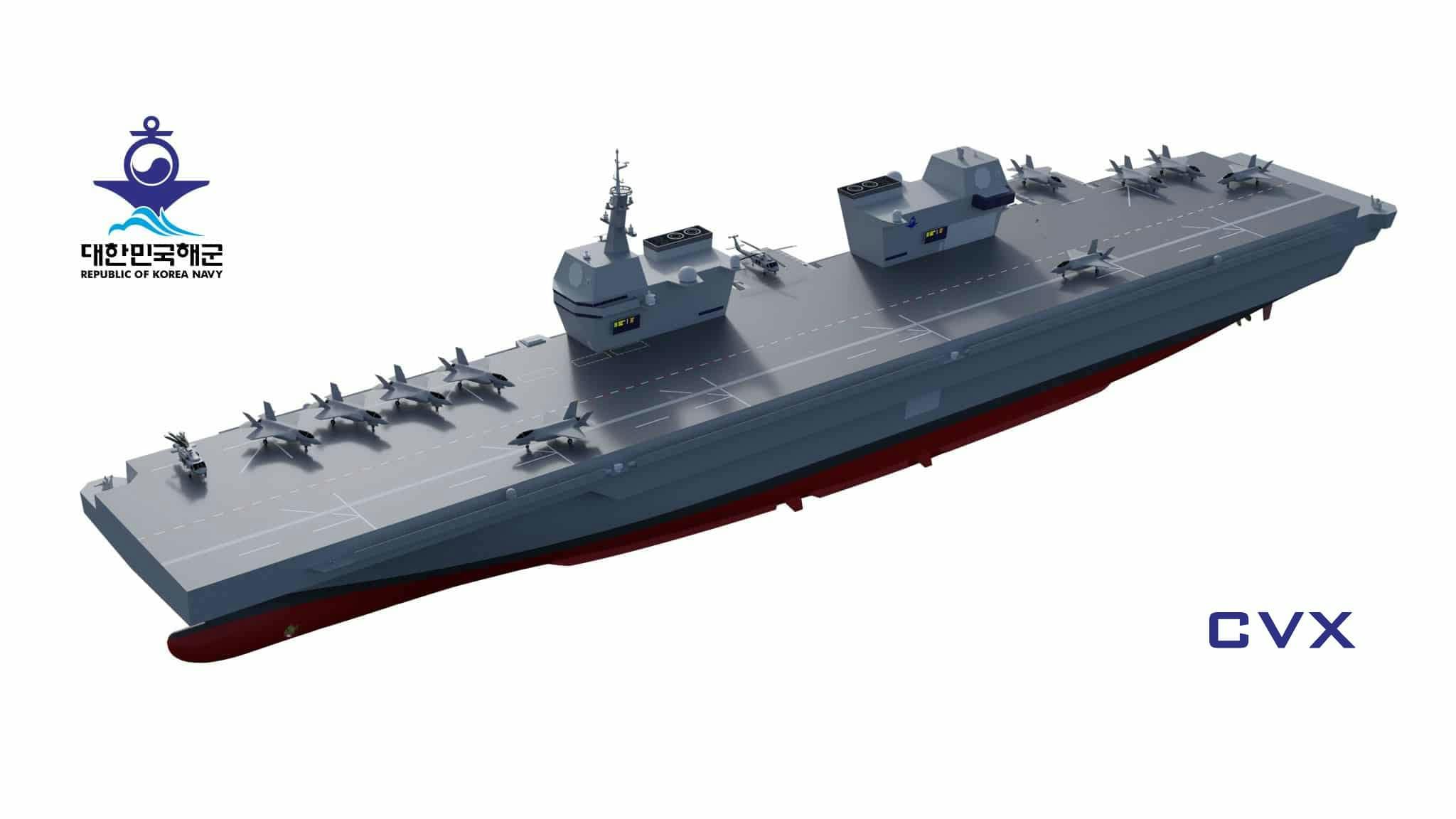
John Howie, Babcock Group’s Chief Corporate Affairs Officer, said:
“As a lead partner within the Aircraft Carrier Alliance that designed, built and delivered the Queen Elizabeth Class Carriers for the UK, we are delighted to be able to sign this Memorandum of Understanding with HHI. Babcock has the proven capabilities to deliver large scale complex programmes and by affirming our already strong relationship with Hyundai Heavy Industries, the world’s largest shipbuilder, our collaborative and complementary skills and expertise can deliver a cutting edge sovereign Aircraft Carrier capability to the Republic of Korea.
Through our growing in-country business, continued long-term investment in our facility in Busan and collaboration with key partners both in Korea and internationally, Babcock is committed to supporting Korean industry in delivering the CVX Aircraft Carrier Programme for the Republic of Korea. We look forward to continuing to work closely with all stakeholders and partners involved in this effort.”
Mr. Sam-Hyun Ka, CEO, Korean Shipbuilding and Offshore Engineering (KSOE), the holding company of HHI, said:
“The MoU with Babcock develops the relationship between a leading aerospace, defence and security company and the number one shipyard in the world. Through this MoU, we will establish a stable foundation to integrate cutting edge technology into the Republic of Korea’s first light Aircraft Carrier build. Furthermore, the capability of both companies will help to grow future technology opportunities in the global market.”
Simon Smith, British Ambassador to the Republic of Korea said:
“I welcome this Memorandum of Understanding between, Babcock International Group, KSOE and HHI. It is another excellent example of the strong ties and growing industrial cooperation between the UK and the Republic of Korea, that is so beneficial for both countries. Babcock is representative of the thriving British naval sector, which the UK can offer Korea. Working with KSOE and HHI – one of the world’s largest shipyards, makes a perfect partnership for what will I’m sure be a fantastic and prosperous venture.”
Brigadier Mike Murdoch, MOD Defence Attaché to the Republic of Korea said:
“As a member of the Aircraft Carrier Alliance, Babcock helped build the Royal Navy’s cutting-edge Queen Elizabeth Class Carriers, some of the world’s most advanced ships, and the prospect of bringing their knowledge and expertise together with HHI through this MoU on Carrier Design is very exciting. The timing of the MoU, signed between Babcock and HHI, is also particularly fitting as HMS Queen Elizabeth visits Korea at sea. The Royal Navy are keenly supportive of our friends and colleagues in the Republic of Korea Navy and this MoU shows how the UK and Korean industries are moving towards a closer relationship.”


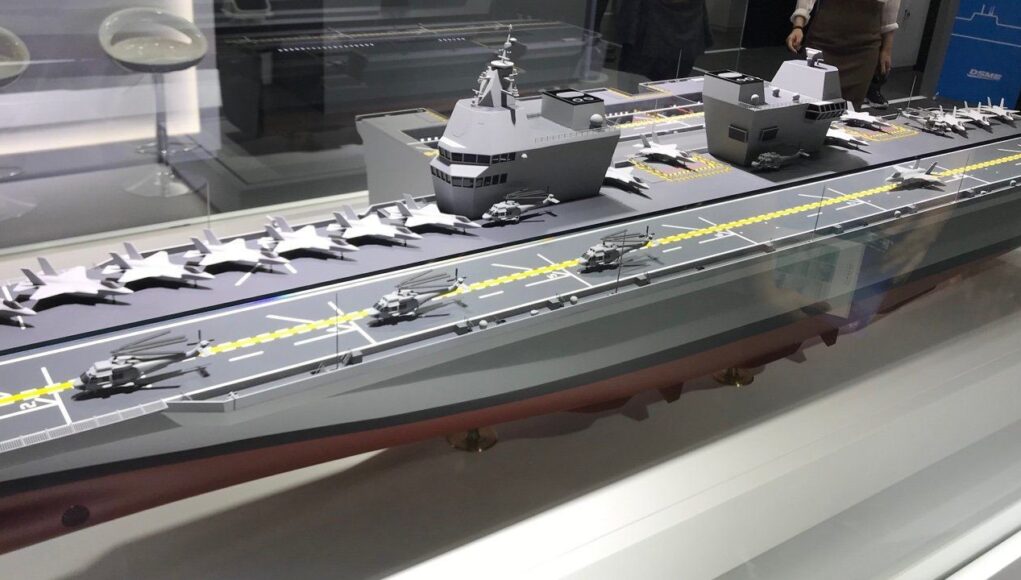
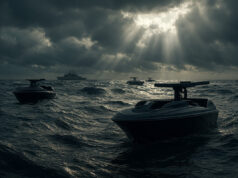
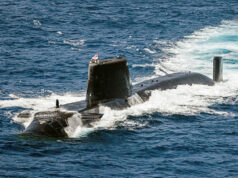

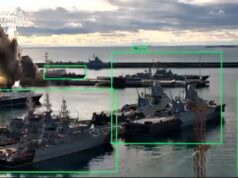


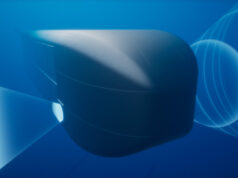
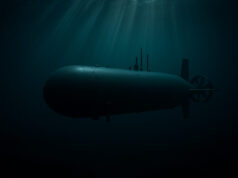



Interesting Island layout, wonder where they got that idea from….
Where the UK goes, other’s will follow…
This should have been written that after all who had known about the past die! 🙂 I first came across the following during 1990s. Just check the concept, Row 8, Column 1:
This should have been written after all who had known about the past die! 🙂 I first came across the following during 1990s. Just check the concept, Row 8, Column 1:
From Italians 😀
🙂 Fincantieri is in the other side with Daewoo. Also a 2 island proposal.
From June Defence News:
“On the first day of MADEX, the shipbuilder signed a memorandum of understanding with Italy’s Fincantieri to assist with the conceptual design for the CVX project.
“Fincantieri will advise DSME based on the expertise gained with the construction of the LHD [landing helicopter dock] ‘Trieste,’ which will be delivered next year to the Italian Navy,” the Italian firm said in a statement, “With this agreement, Fincantieri strengthens its presence in the country, further boosting the relationship with the Republic of Korea.”
The image posted looks like the Daewoo model.
HHI one appears to be significantly bigger.
Yes, it’s an interesting design concept, somehow it looks familiar…
What are the arguments against the ski-jump for RoK?
I’d imagine a deck space argument, same as the US use. What is the effect on the take-off load for an F-35B, does anyone know? I assume that is what is helped by having a ski jump?
A ski-jump allows for heavier aircraft, or aircraft with a heavier load, to take-off. Basically it seems the Koreans have determined that deck space is more important than the carrying load of each of their aircraft.
Also reduces wear on the lift fan as you don’t gave to run it flat out for take off or for so long.
But as you say the main advantage is payload fuel load at take off.
The advantages of a ski ramp far outweigh the reduced space on deck (one or two aircraft). For one thing flat decks will have limitation’s to high sea states, ski ramps can always send the departing aircraft sky wards which means wider operating limits than a flat top. In the Falklands SHAR’s launched regardless but with a true flat top many sorties would have been cancelled and we would have lost far more ships because of lack of CAP. SHAR’s and GR7/9 could launch at max load, not always possible with flat tops.
Depends on the layout and the priorities. The USN sees a Skiramp taking up 3-4 HLS spots on their LHAs.
I really don’t get this I did a bit of visual photoshop research a while back using the Australian ships (provided with ski jumps that originally weren’t even going to be used as it would have been costly to remove them from original design) against the Wasps and I could, even taking into the formers smaller size the loss of only one space by comparison. More significant it seemed to me was the port lift which itself affects that aspect of effective desk use. Now this Babcock design like the QE class has two starboard lifts and thus more usable and practical landing space in reality so being quite large too they could well afford a ski jump and probably still be as, or more efficient than the Wasp/America design in practice. I think much of the thinking is bound up in tradition certainly with the yanks and I wonder that influencing the Koreans too while also I wonder avoiding complexity in their minds in training pilots, with range and load being less crucial in their minds. I just don’t see logic supporting the omission while perhaps interestingly some seem to suggest this carrier is more about prestige than actual necessity for the RoC. But being conclusive on that view is above my pay grade.
HMAS Canberra has 6 HLS spots, USS America has 9, and although Canberra displaces a lot less than the Americas, they’re only about 30m shorter. Given that the USN usually claims that adding a ski-jump would remove 3-4 HLS spots that seems in line.
The Port Lift on a Canberra takes up a similar kind of space to the SAM battery on a America/Wasp (absent on a Canberra), so I’m not sure that really makes a difference, (Plus the America HLS’s are spaced so that you can access their deck edge lifts while the HLS is in use).
For the Babcock design: It looks like it has 9 HLS’s, in almost exactly the same layout as a America class LHA, looking at where the Ski Jump would go it would at least take out the front two HLS’s (one is right where the ramp would have to go, and the one beside it would be taken out by the turbulence creating obstruction right next to it.)
Then look at the Ski-jump on the Queen Elizabeth’s, they have 6 HLS’s, (QE 280m vs America 250m, could probably squeeze them closer together and fit an extra HLS in there tbh), but none of them are fwd of the Island, where the Ski-Ramp is. Remove the Ski-Ramp and you could easily fit another 3-4 HLS spots there.
We have never experimented with one. The Marine deployment in HMS Queen Elisabeth is providing months of new data under all operational conditions. I expect minds to change.
The US Marine Corps has plenty of experience with ski-jumps, there even was a USMC sqn stationed aboard HMS Illustrious in the early 2000’s.
Interesting, but according to USMC sources, this is the first deployment to a UK carrier since WW2.
I mean, that might be one of those “technically true due to the nature of the wording.” things. But it certainly isn’t the first time USMC aircraft have operated from a UK carrier since WW2. Below is a USMC F4 Phantom flying off of HMS Ark Royal in the 1970’s.
Interesting. Obviously, Marines have a story of operating in UK carriers. Of course, at the time they were operating similar aircraft. The F-35B is making similar arrangements practical again and likely to involve more nations. Thanks for the info. Now I need to wonder about the USN. 😎
See attached image.
Thanks. It would be interesting to find out how long they were on the Illustrious.
or
Also the USN built land-based Skiramps in Patuxent NAS years ago to do tests with…
You are correct, but I was referring to operational USN ships, no testing. With the information, you shared about a USMC Harrier deployment on HMS Illustrious. I understand now why the USMC deployed on the HMS Queen Elisabeth. In the works, a future USMC F-35B deployment in a Japanese carrier and I expect South Korea would be next. So what Australia is waiting forth?
Australia doesn’t have Aircraft carriers, so probably that. 😂
Actually, they do. Because they can modify their Canberra class helicarriers the same way that the USA, Japan, and South Korea are doing or planning to do with theirs. I think you’re failing to realize how much of a gamechanger F-35Bs are. Heck, anything that floats with a compatible flight deck can now become a carrier.
Actually they don’t. The Canberras are a different kettle of fish to the Americas, Dodku’s and Hyugas. They’re only superficially similar the Juan Carlos I, and currently couldn’t handle F-35s (or really any fixed wing aircraft) trying to operate off their decks, and would require a *major* refit (to the point it would almost be cheaper to acquire a new dedicated carrier rather than refit both of them) .
Look at my comments below. The modifications to allow their Flight deck to operate 35B are not that extensive. relatively speaking and would allow them to Lilly-pad lightings from other nations. Because sometimes you need VTOL fixed-wing aviation support.
The modifications to other LHD’s aren’t that extensive, but because the RAN modified the JCI design when they built the Canberras, for the Canberras specifically yes, the modifications would be that expensive. Hence why it’s a different Kettle of Fish to the other LHD’s that are being converted to operate F-35’s.
I understand the reasons why it’s advantageous, but that doesn’t change the fact that it’s not going to happen any time soon.
I’d tend to agree: as did RN with the invincible class & Hermes.
My only comment would be that you could take off and land in high sea states with full VSTOL and the ski ramp was t essential apart from payload and range. Without the ski ramp the CAP value of the SHAR would have zero as it’s time on station would have been so minimal as to make it useless.
I can’t quite figure the rational of this design.
The whole thing makes little sense 20 F35B so maybe 8 onboard?
Limited operational radius unless the plan is take off light and then drone refuel?
Something missing here!!
Vanity project ?
Maybe or maybe gently entering flat top world?
Yep maybe but very expensive entry !
Yes that accusation has been made so maybe style over substance might be something of a factor. One has to remember the intrinsic animosity between Korea and Japan and there is definitely a sense of pride in outshining their neighbour.
Well it wouldn’t be the first or the last time !
Probably. South Korea don’t need a Blue Water Navy. Their main, probably only potential adversary is NK and land based aircraft should be able to cover any eventuality therein.
Actually, they do. Because NK is not the only potential adversary. Despite their current leadership-friendly approach toward China. South Korea watches a belligerent China with apprehension. There had been a reported increase in Chinese incursions into the South Korea ADIZ and Economic zone. These concerns are shared with their neighbors which explains why all are buying compatible weapons systems.
Not at all. Very real threat from both N Korea & a huge expansive, bullying PLAN. It’s a very real arms race, though for all the PLAN are acheiving, the likes of S Korea, japan, Austrailia & others are doing a good job at collectively matching them.
Maybe more focus on LHA role rather than carrier, like the Americans. Primary focus on Helo, with small numbers of F-35 to provide a bit “extra” rather than a Aircraft carrier with some Helo’s embarked?
Had similar discussion in relation to USS America and why ramps aren’t fitted. It just doesn’t make sense to me to spend $100m on an aircraft and then cripple it’s safety,range and payload. The other explanation was that the F35’s were intended to deploy and operate from land bases. The carrier was simply a means to get them there. Then why build a sophisticated and expensive ship in both cash and crew terms to do such a relatively mundane task.
Depends what you want the carrier to do. If you only are buying 20 carrier aircraft (as South Korea is planning), but have a large helicopter fleet, then it makes sense that you’d prioritise the Helicopters over the fixed wing aviation.
*Edit* Re-USS America and co; their prime purpose is to put Marines ashore. The Fixed Wing assets are just support for that primary mission. That’s why they are geared towards getting as many helicopters airborne as quickly as possible, both to put troops ashore, and to give them rotary support in the form of attack Helicopters.
You are correct. But not only the F-35B can provide air superiority over the landing zone. But with its advanced electronics also served as AWACS, spotter for over the horizon fires, and as part of the anti-missile defense.
Except for the F-35C and F/A-18’s operating off a CVN. But assuming one of those aren’t around then yes, which is why Wasps and Americas have decks capable of handleing F-35’s and Harriers. Not saying they’re not useful, just that the LHD/LHA’s are geared toward Helicopters as their priority.
I going to presume you’re not American. I would suggest that you read Proceedings from the US Naval Institute and get acquainted with our latest thinking. Bottom line, with F-35B, our LHD/LHA no longer required fleet carriers’ air support. We are being set up to engage in a distributed fight. So the more decks the 35B can cross deck with. The more targets any potential adversary needs to worry about. Even if they don’t acquire Lightings, it would be advantageous for Australia to modify the Canberra’s to be able to operate them. Because, they could then handle allied air support coming from the US, UK, Japan, and South Korea. Instead of waiting for their carriers to come to their help. Win-Win.
1) Whether I’m American or not is rather irrelevant.
2) I wouldn’t presume anything if I was you.
3) Yes it would be advantageous, nobody is disagreeing with that.
4) They’re not going to do it anytime soon, money is always a factor, and saying “The Auzzies should refit the Canberras to operate F-35’s” is currently as much in the fantasy fleet realm as saying “The RN should have 15 Type 26s.”
Aussies… not.. Auzzies…
I can’t be the only one who has thought of a retractable ski jump. It pops up when needed and is flat on the deck when not.
I’m not an engineer so can’t say how much room the pop up equipment will take up but I’ve never even seen it discussed or studied anywhere.
They have had almost endless debates military and political about the best use of the Americas and even how best to get the marines onto the ‘beach’ the first two emphasise heli use the next ones will reference back to the Wasps in terms of using landing craft too. Emphasising heli for this job you can understand a reluctance to have a ski jump on balance. However since their design there has been great debate about just how far off any coast they will have to operate which has an impact on the effectiveness of the F35b and arguably questions the decision to re emphasise sea delivery balance over specialist air delivery of the first two.
If as some commentators have argued that they (or some at least) should be utilised as support carriers then that again pushes the argument on a bias towards maximising F35b effectiveness over extra heli landing spots as per QE does. You can have sympathy for arguments on both sides and I’m sure it will continue and develop probably without any particular conclusion… at least until a conflict adds weight to one argument or another.
Good points. Thanks.
They probably decided air to air profile is most likely with Chinese rather than heavy ground attack. Also they are likely to be operating in area around their nation, not much chance of taking the fight to the enemy homeland,
None of the models presented are definitive.
It’s anecdotal, but I did read somewhere (fairly official) that the HMSQNLZ can launch F-35Bs at full fuel and weapons load via the ramp. I’m not sure whether that is a full internal and external load, or just internal on the weapons side of things though.
It’s max fuel and max weapon load out from the QE class Joe.
The aircraft would simply take a longer takeoff run. We lucky to have such large decks to play with.
Many points as listed, another is a 50 ft jump, which gives a pilot 10/15 secs if anything goes wrong. USMC loves them for safety over the wasp.
but claim they take up 3 landing spots. BUT if you look at The Wasp-class or similar platforms. Runway section of landing is kept clear. so guess its more of its not our idea and what does the UK know about carriers…
Just seems madness. For the sake of 2 or 3 extra planes, you can probably cover their work with the planes you do have because they can carry more weapons and fly further thanks to the jump!
Indeed there is potential use and practical use when in action and often it’s difficult to get solid answers outside of serious real time experience. For the life of me I can’t see how a port side lift doesn’t potentially interfere with deck operations unless the laws of dimensional physics have been changed. I presume it’s a compromise they are willing to accept, it has some other functional advantage to compensate for its disadvantage, or as is not unknown and indeed with other design aspects of the Americas it’s possible it’s just that it is an unquestioned carry on from previous classes.
We could just build them a QE carrier and in return they could build us a Dokdo LPH to replace Ocean…..
Great to see Babcock involved and this hopefully keeps the aircraft carrrier design skills going for the UK as well – through Babcock.
Can I ask What is an Axial flight deck ?
Thanks
Keith Simmonds
An Angled Flight deck is a flight deck that is placed at an angle to an Aircraft Carrier, and Axial flight deck by comparison is is one that is in line with the Aircraft carrier.
There is a lot of negative support with this project in the Korean National Assembly (Parliament), who don’t see the need for a carrier and that the money would be more wisely spent on developing nuclear submarines.
Their view is that the North Koreans are not in a position to neutralize the South’s airfields. But also the other competing neighbouring Nations such as China and Japan will be building more than 2 carriers.
It will be interesting to see how this project progresses? According to some reports the ship will be about 265 m in length, 43 m in width and have a light and maximum displacement of around 30,000 tons and 40,000 tons respectively. The ship will be capable of operating 16 F-35B fighters as well as eight helicopters. It will also feature a high degree of automation and have a complement of 440 crew, excluding the air element. This will make it larger than the Japanese Izumo class and similar in size to the new Italian Trieste class.
Interestingly the model shown in June at MADEX did incorporate a ski jump but not sure if that was a generic concept or whether it was specifically the initial concept design by Fincantieri and Daewoo.
Out of interest does Trieste have a ski jump does anyone know? I had oddly seen pics and drawings of it with and without one so not sure if there is a liberal use of photoshop or whether the jump has actually been added later.
Pretty sure the MM has put a ski jump on Trieste, but they’ve definitely flip flopped on it a lot.
Yes, they have put one in Trieste.
A spare third carrier for the RN anyone? As a backup, littorial patrol-support, anti-submarine, especially for Northern approaches?
How would you pay for it/support it? What programs/capabilities would you cancel to fund it? Would be an awful waste of money if it was a backup/littoral patrol support vessel…. Wouldn’t it be too big/expensive for anti submarine work, after all the invincible ships were purpose designed for that work and were less than a third of the tonnage…
As others have suggested, I’d like to see the RAN here in Australia have this sort of medium carrier capability especially in our Indo Pacific region.
We know the benefits of the twin towers on the larger carriers, but would this carry over onto the smaller LHDs.
and a direct assault as the towers are fairly close together….
The new Italian ships have them though I was surprised to see that the second lift isn’t incorporated in that area like QE but has a port one instead. I am sure there must be layout complexities that must dictate this or other preferences but seems odd to me.
IS AN lhd, not carrier
Interesting just read that while QE is marked out for 6 heli spots it could potentially be marked out for up to ten medium heli spots if it were to be operated as a specialist heli carrier like the Americas, seems a little optimistic even from my viewpoint but shows these aspects aren’t quite as black and white as they may superficially seem.
The image is the competing Daewoo design. The Babcock HHI design has a ski jump. https://www.navalnews.com/naval-news/2021/09/south-koreas-hhi-and-babcock-ink-strategic-alliance-for-cvx-aircraft-carrier/#prettyPhoto/0/